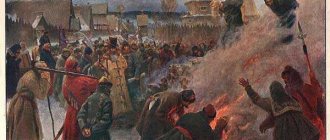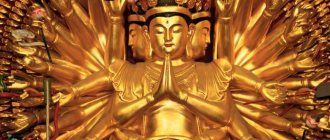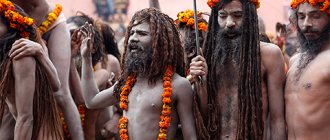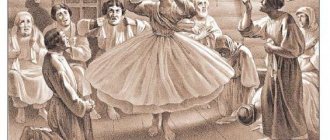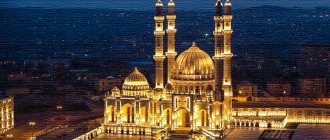Krishna. To understand the adherents of a new religious movement for Europe (and Russia, in particular), it is necessary to know who Krishna is. Is it God, a prophet or one of the many idols of the Hindu pantheon? Let's figure this out. Are Hare Krishnas adherents of monotheism or do they profess polytheism? They say the cult comes from India. But the Hare Krishnas themselves claim that they believe in one God. Moreover, they claim that there is no fundamental difference between their religion and Christianity. After all, even the names of the Messiah were the same. Krishna and Christ, according to some supporters of the cult, are two hypostases of the same God. Which one? Let's find out from this article.
Who is Krishna?
Photos printed in religious literature often present to our eyes the figure of a person with a strange skin color. Translated from Sanskrit, “Krishna” means dark blue. And in religious texts the skin color of this God is described as “similar to blue clouds.” This is how he is portrayed on the pages of the Bhagavad Gita, a book that, without a doubt, can be called the “Bible of Krishnaism.”
Krishna
But God is also a character in other religious texts. These are the Bhagavata Purana, Vishnu Purana, Mahabharata and Harivamsa. And here confusion arises for the European. In some texts, Krishna is a charming baby playfully stealing butter from his mother, in others he is a cow herder and an ideal lover or a courageous warrior giving instructions to his friend Arjuna. But above all, he is the eighth avatar of Vishnu. And this last one is one of the key gods of the Hindu pantheon.
Cult
As in all Hindu religions, adherents of this teaching gather in ashrams. This is not a temple in the Christian sense of the word. An ashram can be an ordinary apartment or house. This is a place where the community gathers to engage in spiritual practices under the guidance of a guru. The word “ashram” itself means “protection”. That is, they come there under the care given by the attracting Krishna. Photos of ashrams show that there is a sculptural image of the deity, often not alone, but with his girlfriend Radha. By the way, she is associated with the female form of Krishna. Believers offer prasad to the deity - ritual food, which is prepared out of love for God and his children.
Krishna's story
According to sacred texts, in the fourth millennium BC, Vishnu descended into the material world from the spiritual, born in the form of a man in the city of Mathura, as the eighth child of Vasudeva and his wife, Princess Devaki. He came to show people his religious principles and show divine deeds. In the episode of the birth of Krishna, many similarities can be traced with the biography of Jesus Christ. So, his mother’s brother was predicted that he would die at the hands of his eighth nephew. And this king did everything to kill his sister’s child. Krishna saved himself from death in a slightly different way than Christ. It was a mystical transfer of the baby to his adoptive parents - the shepherd Nanda and his wife Yashoda. During this period of his life, Krishna is portrayed as an ideal youth playing with cowherd girls and his beloved Radha. When he matured, he returned to Mathura, killed his uncle and returned the throne to his grandfather. After this, Krishna befriended Prince Arjuna and gave him moral instructions before the Battle of Kurukshetra. But a hunter with the eloquent name “Old Age” (Jara) wounded him with his arrow.
Origin and essence of the Hare Krishna movement
In modern Western technocratic society, young people are showing an increasing interest in the religious ideas of the East. Many young people tirelessly seek the spiritual meaning of life, a different reality, and the purveyors of Eastern ideology offer them a wide choice of religions that were completely unknown in the West just a few years ago. The International Society for Krishna Consciousness (ISKC) is one such denomination that enjoys undoubted success.
The ISKCON sect owns a whole network of temples and monasteries - communes (ashrams) in cities in America and other countries. Members of the sect, worshipers of the Hindu god Krishna (whose name they prefer to pronounce as Krishna), seek to cleanse the poisoned atmosphere of modern society by spreading and propagating the teachings of “Krishna consciousness”.
Over the course of its long history, Hinduism has been modified and reborn more than once, dividing into separate branches and movements, giving rise to new religions. Two of the most significant branches of Hinduism are Shaivism and Vaishnavism. Supporters of the first worship Shiva as the highest deity, while supporters of the second consider Vishnu and his incarnations to be the main god. Most Vaishnavites consider Krishna as one of the incarnations (avatars) of Vishnu. Several centuries ago, however, divisions occurred again among Hindus, and some Vaishnavites came to the conclusion that Krishna was the supreme god, and Vishnu, on the contrary, was one of the incarnations of Krishna.
The founder and ideologist of the new movement was Kaitanya Mahaprabu (1486-1534), who revived the mass worship of Krishna in Bengal. Inspired by the Bhagavad Gita, the most significant of the Hindu sacred texts, Kaitanya declared that liberation (mukti) is achieved through selfless love and service to Krishna, the supreme, personal deity. This teaching is known as “bhakti yoga”. Kaitanya introduced special rituals of worship (sankirtana) - chants and ecstatic dances. Modern devotees of Krishna continue this tradition.
The Kaitanya Krishna sect was criticized by many Hindu philosophers, but survived and is now spreading in Western countries. The Hare Krishna cult of “bhakti” penetrated into Western culture thanks to the efforts of Bhaktivedanta Swami Prabhupada. Bhaktivedanta was born on September 1, 1896 in Calcutta; his real name is Abhay Charan De. He studied philosophy, economics and English at Calcutta University (until 1920), and in 1922 became a disciple of Sri Srimad Bhaktisiddhanta Saraswati Goswami Maharaja. In 1933, Saraswati initiated his student into the bhakti-yoga tradition. A few days before his death in 1936, Saraswati bequeathed to him to spread the principles of “Krishna consciousness” among the English-speaking peoples. In 1947, Abhay Charan De took the new name Bhaktivedanta, and in 1950 he left his wife and children and became a monk. From that time on, the title Swami was added to his name. In 1962, he founded the League of Initiates in Delhi and began studying and publishing selected texts of the Vedas.
A.Ch. Bhaktivedanta Swami moved to New York in 1965; Appearing on the streets in the very center of Manhattan, he presented a very entertaining sight: a seventy-year-old old man from India, dressed in a saffron-colored robe, begged for alms and tried to convert those he met to his faith. Gradually, his first students appeared, and in 1966 he founded the International Society for Krishna Consciousness. In 1968, Bhaktivedanta began publishing numerous works - mainly translations of Hindu sacred texts and commentaries on them. To date, more than 30 books have been published by “His Divine Grace A.C. Bhaktivedanta Swami Prabhupada”, published and distributed by ISKCON.
Hare Krishnas continue to establish new temples around the world, especially in the United States. They publish a monthly magazine, Back to Godhead, and distribute it on the streets. They also distribute recordings of songs by former Beatle George Harrison containing Hare Krishna mantras and hymns to Krishna. Hare Krishnas strive to proclaim the name of Krishna in all cities and towns of the world.
They proudly declare that their organization is the fruit of the efforts of a continuous succession of successors to the teachings of “Krishna consciousness” - in reverse perspective - from Bhaktivedanta to Sarasvati, from Saraswati up to Kaitanya - and further to Krishna himself (members of the sect believe that Krishna came to earth 5 thousand years ago). According to the views of Hare Krishna followers, a true understanding of Hindu sacred texts is impossible without the instructions of a spiritual teacher who received his knowledge from the mouth of another guru, and so on, so that the tradition goes back to the instructions of God himself, without interruption at any point. Bhaktivedanta died in 1978, but remains the spiritual mentor of the Hare Krishnas - only his teachings are considered by them to be “the true transcendental science of God realization.” Bhaktivedanta was the authorized representative of Krishna on earth, “confirmed in office” by Krishna himself. Hare Krishnas are obliged to completely subordinate their desires and thoughts to the teachings of Bhaktivedanta.
Bhaktivedanta was inaccessible to most of his fans, who were constantly hoping to see him, expecting his smile as an event of extreme importance. Prabhupada lived in comfort and luxury, surrounded by a retinue of servants. He expressed the desire to live to see the construction of 108 Hare Krishna temples (today there are 70) so that each of his personal 108 students would be a mentor in his own temple. In addition, Bhaktivedanta planned to revive India spiritually, and for this purpose, a world center for the movement is being built in India, and its construction costs many millions of dollars. *
The movement is currently led by 11 gurus. Each of them is assigned a geographical territory. Since Bhaktivedanta's passing away, the methods of collecting money used by the Hare Krishnas have changed and attracted the attention of the law. The Krishna Consciousness Society had to justify itself in court - the Hare Krishnas were accused of forgery and even theft. The new leaders of the movement, however, insist that Hare Krishnas are allowed any methods, since everything in this world belongs to Krishna in one way or another.
There are certain reasons why the Hare Krishna movement is attractive to young people. Some express their disgust for modern technocratic society in this way, trying to forget about the anxieties and disappointments of material life. They hope through joint efforts to find their place in the world, to find the spiritual meaning of existence. The propaganda of the Hare Krishnas finds a response mainly among students and young people who are disillusioned with the “drug culture.”
Some people are drawn to a sect by a feeling of loneliness, isolation, and loss of a sense of personal identity. The Hare Krishna movement offers these people a well-organized, disciplined community: the lives of the sect members are subject to a rigid schedule and strict rules. All decisions are made by one authoritative leader, and they are executed collectively. Everything is predetermined, cases of disobedience are very rare, and people living in communes are overcome by a feeling of calm and security.
Potential converts (Hare Krishnas call them “karmis”) are invited to visit the temple during the Sunday celebrations. Those who accept the invitation are greeted with flowers and surrounded by universal care. At first, the requirements for new members of the sect are not so strict, but gradually, over time, discipline becomes more and more stringent. The convert is stripped of all the accessories of his “previous personality” and given new ideas befitting a follower of Krishna. All connections with the outside world, conversations about what does not relate to the internal life of the sect, are prohibited, all personal property is given to the sect, everyone must wear the same clothes, have the same hairstyles. Initiated men shave their heads bald, leaving only one strand of hair (“sikha”). Instead of European clothing, they wear yellow or saffron dhotis, reminiscent of robes or loose cloaks. Women wear Indian saris, their hair is braided with a mandatory parting in the middle, and cosmetics are not allowed. All initiates wear a leather belt around their neck containing a chain of beads (japa), 12 markings made with white clay (tilaka) on their body, and another small string of beads around their neck.
Anyone who becomes a follower of the Hare Krishna movement and lives in the temple must obey the existing rules. Abstinence and modesty are required of the members of the commune. Gambling and other games, sports, and conversations about subjects not related to the teachings of “Krishna consciousness” are prohibited. Everything related to science, education, everything sensual, emotional is rejected. The use of drugs, alcoholic beverages, tobacco, coffee, tea and free sexual relations are not allowed. A strict diet is introduced: Hare Krishnas do not eat meat, fish or eggs. All members of the Hare Krishna commune sleep on the floor, usually in sleeping bags.
The day of the Hare Krishnas is subject to a strict schedule. Members of the commune rise at 3.30 am, chant, perform rituals of worship and offer food sacrifices to the incarnations of Krishna; then the collective breakfast begins. During the day, Hare Krishnas study Hindu sacred texts and the writings of Bhaktivedanta. The classes are accompanied by chanting, fingering beads (japa) and temple maintenance and repair work. Some light incense, others sew and paint; clean, prepare food and care for the statues of deities. Some initiates go out into the streets in groups, singing and dancing. They collect alms, sell books and incense, and distribute the magazine “Return to Divinity.” In general, the movement receives good income from book sales and alms. All members of the commune go to bed at 10.30 pm.
After six months in the temple, the convert undergoes initiation by fire and receives a Hindu name from Prabhupada. After another six months, the second rite of passage is carried out - the convert receives his secret “mantra” and becomes a Brahmin.
Since Bhaktivedanta's death there has been a certain liberalization of the Hare Krishna movement. They are no longer required to part with all their property and live only in the temple. But they must remain vegetarian and have a Krishna altar at home. Public chanting of hymns gave way to the sale of vegetables and fruits grown without the use of chemical fertilizers.
Hare Krishnas use many Sanskrit words, since Sanskrit is the sacred language of the Hindus, the language of their sacred texts. Prayers and readings are said in Sanskrit. In the end, the “children of Krishna” must turn all their thoughts only to this god, all their actions are serving him, they must lose their sense of self and merge with Krishna.
The system of worshiping Krishna can be very simple or very complex, depending on the level of “Krishna consciousness” the devotee has achieved. The simplest method of worship is as follows: the convert keeps images of Krishna and Kaitanya in his home and periodically recites the basic Krishna mantra: “Hare Krishna, Hare Krishna/ Krishna, Krishna, Hare, Hare/ Hare Rama, Hare Rama/ Rama, Rama, Hare, Hare " These 16 words are believed to produce a kind of “transcendental vibration of sound.” Rama is one of the names of Krishna, and Hare means many things, including Krishna's ability to bring pleasure. Bhaktivedanta teaches that this mantra is the only way to spiritually find oneself in the modern world. Many Hare Krishnas recite the mantra 108 times (corresponding to the number of japa beads) 16 times a day.
Another Hare Krishna ritual, the so-called sankirtana, can be seen in temples, parks, schools and just on the streets. During sankirtana, Hare Krishnas tell each other about the pleasures that Krishna indulged in while on earth, chant mantras and dance. Many of those singing and dancing fall into a state of ecstasy or trance.
Let us list several other rituals and rules associated with the technique of bhakti yoga, serving Krishna:
(1) Prasadam - preparing special food and offering it to the deities of the temple.
(2) A Krishnaite should constantly think only about Krishna, about the name, form and “pleasures” of Krishna.
(3) From two to six times a day, the ritual “aratrika” is performed - “greeting the Lord.”
(4) Worship of the sacred Tulasi Devi - a plant found in all temples. This ceremony is believed to cleanse the worshipers from sins and diseases. The sacred plant is cared for with great care and attention.
(5) Serving the deities of the temple. Each temple has a special room decorated with statues of Krishna playing the flute and his beloved concubine Radha. These statues, up to half a meter high, are placed on the altar along with three smaller wooden images of deities, images of Kaitanya and his spiritual successor Bhaktivedanta. The statues are dressed in silks and jewels. They are washed, “fed”, they are prayed to, they are caressed, their clothes are changed, like dolls, they are put to bed. Devotees claim that these statues are special incarnations of Krishna and not idols. Hare Krishnas drink the water they wash the statues with.
(6) Certain fasts and holidays are observed. The three most famous annual festivals of the Hare Krishnas are the “Appearance Days” of Krishna, Radha and Bhaktivedanta.
Acts of worship are intended to arouse in Hare Krishnas feelings of self-sacrifice, self-forgetfulness and tenderness. There is a temple schedule for worship, but ideally it should be continuous. Members of the sect are constantly reminded of the imminent danger of spiritual destruction; despite the imminent danger of spiritual destruction; Despite this, the number of disillusioned Hare Krishnas (“apostates”) is increasing.
The structure of the ISKCON organization is simple. Since the death of Bhaktivedanta, the Hare Krishna community has been governed by temple masters who have unquestioning authority in their communities. Women are considered beings of a lower order: they are entrusted with the service of male Hare Krishnas. According to the decision of the mentors, marriages are concluded. Wives cannot contradict their husbands; a husband has the right to beat his disobedient wife.
Married couples are selected by mentors. Bhaktivedanta taught that marriages are made only for those who are unable to remain chaste, for the ideal Hare Krishna should abstain from sexual intercourse: sexual sensations supposedly instill in people a materialistic outlook on life. Marriage is permitted only for the purpose of procreation. Children of Hare Krishnas are given sacred names in Sanskrit; obedience to the strict rules of the community becomes mandatory for them when they reach the age of five. Subsequently, children are taken from their parents and sent to special ISKCON schools to learn the basics of religion. Hare Krishnas hope that their children will achieve perfection during their lifetime and will not need reincarnation.
We have already mentioned that one of the most important ideas of the Hare Krishna movement is the uninterrupted succession of spiritual mentors from Krishna to Bhaktivedanta. Hare Krishnas look down on other Hindu gurus who charge money to their students, teach unity with God through meditation, and at the same time allow them to indulge in material pleasures. Hare Krishnas claim that such gurus are false teachers who are not the successors of the true teacher. A person comes to God only by obeying a true spiritual mentor. The mentor is the representative of Krishna on earth; only he can impart true knowledge and teach others how to please Krishna. Pleasing Krishna is nothing other than pleasing the spiritual master, the material incarnation of Krishna. The initiate serves the mentor and only in this way acquires the spiritual meaning of life. One who displeases a spiritual mentor does not enjoy his mercy and cannot grow spiritually.
In his teachings, Bhaktivedanta ascribed to himself absolute authority. His translations and interpretations of Vedic texts also have undeniable authority. For example, his translation and commentary on the Bhagavad Gita, published under the title “Bhagavad Gita As It Is,” claims to be the only accurate interpretation of the text. ISKCON does not accept any other translations of the Bhagavad Gita because they do not support the ideas of the Hare Krishna movement.
“Bhagavad Gita” is the main, favorite sacred text of the Hare Krishnas; they proudly say that it was written five thousand years ago, many centuries before the Bible. But this claim is not supported by any evidence, and most serious scholars place the writing of the Bhagavad Gita sometime between the 4th century BC. and I century A.D. Now the Bhagavad Gita is one of the books of the Mahabharata, the historical epic of the Hindus.
Another sacred text of the Hare Krishnas, the Srimad-Bhagavatam, is more widely known as the Bhagavata Purana. This text was created between the 3rd and 4th centuries AD. Of course, the followers of the Krishna Consciousness Society claim that it was written five thousand years ago by the same author as the Bhagavad-gita. Many Bhaktivedanta books are devoted to translations and commentaries on the Srimad-Bhagavatam, since this text talks about the pleasures of Krishna on earth. These texts and their miniature paintings, from the point of view of ISKCON members, are artistic incarnations of Krishna.
The Srimad-Bhagavatam contains many legends about Krishna, with illustrations often depicting a dark-skinned shepherd boy (Krishna literally means “black”). The book tells that as a child, Krishna loved various tricks and pranks, for example, stealing other people's butter. As young men, he played the flute and called shepherdesses, inviting them to leave their husbands and dance with him at night under the moon. The cowherd boys gathered, and Krishna danced with them so that each of them seemed as if he loved only her. His favorite shepherdess was Radha. Hare Krishnas believe that Krishna's depraved antics are the material embodiment of divine love, which surpasses all human concepts.
Krishna is often depicted with four arms, holding a conch shell, a lotus flower, a mace and a circle. According to legend, Krishna died at the age of 125, unintentionally wounded in the leg by an arrow.
In every century, a new “avatar” appears - the incarnation of Krishna in human form; The last incarnation of Krishna was the “golden avatar” Kaitanya. Our age, which the Hare Krishnas call Kali Yuga (dark age), will last 432 thousand years. In previous centuries, there were their own ways of worshiping Krishna - mystical meditation of yogis, ritual sacrifices and worship in temples. Bhaktivedanta teaches that in this age the only path to salvation lies in chanting the Hare Krishna mantra and selfless service to Krishna through His successors.
ISKCON adherents call Krishna the Supreme incarnation of Divinity; they consider Krishna to be the supreme, personal god, the creator of millions of universes. He also created the “spiritual heavens” with millions of “spiritual planets”. The material and spiritual planets are inhabited by various living entities, including demigods and demons.
The ISKCON movement is based on two important Hindu concepts – “karma” and “samsara” (reincarnation). According to the teachings of Bhaktivedanta, Krishna, the “Supersoul,” created an infinite number of individual souls (jivas). Jiva is the real “I” of a person, and not the material body. Jiva does not die, but is reincarnated into another body after death. The main problem of people, from the point of view of Hare Krishnas, is that they identify themselves with material bodies, and fall into the illusion of material existence (maya) and sin. This process of delusion and self-deception is “karma”. Until a person frees himself from the shackles of “karma,” his soul will be reincarnated again and again; the soul goes through the four sacraments of life: birth, illness, old age and death.
Hare Krishnas believe that the soul needs liberation from the endless cycle of reincarnation. One who achieves “Krsna consciousness” is liberated and given an eternal, spiritual body. The spiritual body lives in the eternal effulgence of knowing Krishna in his abode of Krishnaloka. This is the journey of the soul, the “return to the Divine.” If a person who has dedicated himself to bhakti yoga does not have time to complete the process of “finding himself in Krishna,” he is given another chance. In the next incarnation, the Hare Krishna will be born into a rich family belonging to a high caste.
Thus, sin (“debt of karma”) is the result of self-deception and ignorance. The only path to salvation is selfless service to Krishna; a person is spiritually born when a mentor initiates him into a member of the Hare Krishna community, and then gradually achieves the consciousness of the “Highest incarnation of the Divine.” Followers of the Hare Krishna movement believe that all other religions are wrong and wrong. They often quote Krishna's statement from the Bhagavad-gita (18:66): “Give up other religions and surrender yourself to Me.”
Evaluation of the Hare Krishna teachings from a biblical perspective
(1) The International Society for Krishna Consciousness is one of the few non-Christian movements professing an infinite and, at the same time, personal God. Hare Krishnas speak with conviction about personal communication with Krishna and claim that their faith is a path of love and service. However, bhakti yoga is a system in which salvation is achieved through one's own efforts. To be saved, a Hare Krishna must repeat the “Hare Krishna” mantra countless times, serve his spiritual mentor, carry out all his commands, observe numerous rules and restrictions, perform rituals, etc. Such a concept of salvation is infinitely far from the Christian idea of salvation by the grace of God.
(2) Those who do not achieve salvation in this life are given an unlimited number of subsequent lives - until the process of “liberation from karma” is completed. Everyone must atone for all their sins themselves and get rid of the “debt of karma” - even if it takes millions of years. This idea contradicts the biblical teaching about the forgiveness of sins - one-time and complete. Even if reincarnation were possible (Heb. 9:27 says it is not), each subsequent life would only increase the number of sins, since no one is without sin except God (1 Kings 8:46; Prov. 20:9 ; Rom.3:23; 1John 1:8).
(3) Hare Krishnas teach that sin is the result of self-deception, illusion, but Scripture tells us that sin is a distortion of the image and likeness of God, making a person morally guilty before a holy and righteous God.
(4) Krishna’s life on earth (as his fans imagine it) is very far from holiness and righteousness: as a boy, Krishna stole things “for fun,” and as a young man he copulated with many women, including married women. The life of Christ and the life of Krishna are incomparable. The death of Krishna is incomparable in significance to the death of Christ. Krishna died, wounded in the leg by an arrow, but Jesus Christ was crucified on the cross and rose from the dead on the third day.
(5) Hare Krishna temple services constitute idolatry (see Ex. 20:4-5). Bhaktivedanta denied this, saying that idolatry is the worship of the “material form of God,” and that Hare Krishnas do not worship an image of God as such. They worship God in the form of an image. But all these are just verbal tricks.
What to remember when meeting a Hare Krishna
(1) The writings of Bhaktivedanta are full of closed logical conclusions that follow from each other. To prove his right to absolute authority, he cites discussions about the uninterrupted succession of spiritual mentors of the Hare Krishnas and quotes from Vedic sacred texts. Bhaktivedanta states that his teachings are based not on all Hindu canonical texts, but on the Bhagavad Gita and one passage from the Puranas. Why doesn't he use the rest of the texts? Because they say that Krishna is not the Supreme incarnation of Divinity. He is just one of the incarnations of the god Vishnu. In an attempt to justify such an unorthodox interpretation of Hindu texts, Bhaktivedanta turns to the statements of his Hare Krishna predecessors as absolutely authoritative sources. So, the basis of the Hare Krishna religion is Bhaktivedanta’s interpretation of his own selection from the Hindu sacred books.
(2) The sacred texts of the Hare Krishnas are not historical sources, but collections of legends. It is clear that they were not written five thousand years ago: there is no archaeological evidence to confirm the events described in the Bhagavad-gita and Srimad-Bhagavatam.
(3) It is assumed that it was not Krishna who caused the existence of an endless cycle of reincarnations, nor did he give birth to the evil of material existence. But at the same time it is stated that every individual soul (jiva) had a first incarnation, and from this it logically follows that Krishna (the creator of souls) is responsible for the existence of evil and imperfection of material existence. Krishna created the illusion of the material world (mayu), and Krishna also created the imperfect spiritual world.
(4) The question is that a person is forced either to reject Christ and accept Krishna, or to reject Krishna and accept Christ. There is no third option - their positions are incompatible, and no emotional experiences of “reconciliation of two religions” will help here. Instead, we should compare everything we know about Jesus Christ and Krishna, compare their teachings, compare their lives. Krishna is a legendary character who teaches salvation through one's own efforts. Jesus Christ, the Son of God, is a real historical Person who sacrificed Himself and granted salvation to all who believe in Him. Krishna lived an immoral life, did not suffer for others, and died like an ordinary person. Jesus Christ lived a sinless life, died on the cross, and rose from the dead to give us eternal life.
“Labyrinths of Faith” - Kenneth Boa.
https://heresy.ru/Wc82747b5d65cb.htm
Attributes and names of Krishna
Various branches and teachings within Hinduism give this deity other names. Vishnu's avatar is often called Gopala or Govinda. These names directly indicate a shepherdess and an ideal lover. And for the residents of Orissa, Krishna is Jagannath. Vishnu has more than a thousand names, many of which are also present in his avatar. But the Hare Krishnas have their own interpretation of the name of the deity. If you emphasize the letter “a”, the name translates as “dark blue”. And if it’s “and,” then Krishna means “attractor.” The attributes of the deity also depend on this interpretation. Govinda is depicted as a handsome, dark-skinned youth, often holding a flute. He stands in a relaxed position with his legs crossed. He is often depicted in the company of his beloved Radha. But sometimes Krishna displays the divine attributes of Vishnu - many arms, heads or chakras.
Sect or not
It is definitely difficult to answer the question posed. Too many currents among the Hare Krishnas take ugly forms. If a cult welcomes unquestioning obedience to the creator, if they beat and rape, and also molest children, then it can rightfully be called a sect.
It is known that Hare Krishnas eat only vegetarian food. Even when an adept cannot eat this way for health reasons, he will have to do this in order to remain in the ranks of believers.
If, after joining an organization, a loss of critical thinking begins, a person leaves his job, loses his family, home and money - it means that he has ended up in a sect, hiding behind faith in Krishna to enrich its creators.
Regular donations that adherents bring to the community flow abroad, and believers are shown non-existent churches in the photo, which were allegedly built with this money. Sometimes spiritual leaders consider adherents as free labor, forcing them to build houses for themselves.
All this is wrapped in a beautiful package of holidays and songs that can put believers into a trance state. The main festivals in honor of Krishna include:
- Janmashtami. Krishna Appearance Day or Indian New Year. Celebrated in Russia and Europe.
- Radhashtami. Celebrated two weeks after the appearance of Krishna. Symbolizes the grace of God descending to Earth.
- Sri Balarama. It is believed that Krishna’s “younger” brother, Balarama, is always with him, so he is celebrated separately. He is a model of service and worship in the cult.
- Damodara. A whole month for meditation and spiritual enlightenment, as well as for a variety of bodily restrictions.
Hare Krishnas have many holidays that are celebrated throughout the year. The celebrations are colorful and bright. Adherents dress in colorful clothes, sing and dance in temples and on the streets.
Traditional songs are associated with mantras and praise of one of the names of God. The most famous of them is: “Hare Krishna, Hare Rama.” It is sung slowly at first, and then accelerated in order to enter a trance and achieve enlightenment. It is believed that the mantra helps to cleanse oneself of evil. Hara, Krishna and Rama are the names of Indian Gods.
Thus, the Hare Krishnas can be considered a sect. Some movements have clear totalitarian features. Others treat their followers more gently, but still siphon money out of them. True believers in Krishna can be found in India and the countries neighboring the country. But you need to be careful there too. By translating religious texts to suit their needs, scammers create communities on Indian soil whose goal is to exploit people.
From polytheism to monotheism
The earliest evidence of the existence of the cult of this figure of the Hindu Olympus dates back to the fifth century BC. But gradually the qualities of Krishna began to distinguish him from other gods. In the ninth century AD, his cult became extremely popular in South India. And after another three hundred years, such religious schools as Srinathji (Rajasthan), Vithoba (Maharashtra) and Jagannath (Orissa) were formed and crystallized. Krishna was endowed with such qualities as “eternal youth”, “emitting radiance”, “truth”. And finally, in the last version - Gaudiya Vaishnavism - he is assigned the attribute of one God - the so-called Absolute Truth.
Interesting facts about Hare Krishnas
Let's look at some interesting facts about the Hare Krishnas:
- Krishnaism in India is the official religion.
- Prabhupada was a nationalist before creating the sect.
- Beatniks and hippies took an active part in the spread of religion in the West.
- Vegetarian restaurants are places where new followers are recruited.
- In Siberia, the sacred scriptures of the Hare Krishnas were declared an extremist book.
- Ayurveda is considered the basis of medicine.
- Before meals, adherents of the cult offer all dishes to God.
- Most adherents of the cult get up at 4 am to start the day with prayer.
- Hare Krishnas are against gambling.
- Sex in the community is only permissible between spouses.
- It’s easy to become a Hare Krishna, just join the nearest community, but leaving the sect is difficult.
How to relate to the Hare Krishna sect is a personal matter for each person. Meanwhile, the teaching spreads over large territories every year, attracting new adherents every day. The Hare Krishnas are not a poor organization; only those members who occupy the lowest levels of the cult are poor. To truly understand the story of Krishna, it is necessary to study the archaeological and historical materials of Indian culture.
Educational film - who are the Hare Krishnas? Watch the video about this:
Western Hare Krishnas: who are they?
In the sixty-sixth year of the last century, the preacher Bhaktivedanta Swami Prabhupada founded the religious organization “International Society for Krishna Consciousness”. He carried out the will of his mentor Bhaktisiddhanta Sarasvati and translated the basics of Naudiya Vaishnavism into English. At that time, Roman Christianity was in crisis. New trends have captured those thirsty for sacrum with their exoticism. The founders of the International Society for Krishna Consciousness first registered in the USA, then similar organizations began to appear in Western Europe. With the fall of the so-called Iron Curtain, religious communities began to appear on the territory of the former Soviet Union. But these people in white and saffron robes, shaving their heads, are not the only ones who believe in Krishna. The “Society of Consciousness” is just one of the many religious movements within Vaishnavism. They call Krishna the supreme deity, the Absolute.
Hare Krishnas in Russia
ISKCON is the largest Hindu organization in the Russian Federation. The association has been operating in Russia since 1971. The first Hare Krishna converts in the country were members of the intelligentsia.
Until 1988, religious adherents were persecuted by the KGB. Afterwards, the sect was rehabilitated and included in the list of religious denominations whose work is permitted on the territory of the Russian Federation. During the Soviet Union, Hare Krishnas were locked up in psychiatric hospitals and also sent to prisons. At that time, any religion was outlawed, and atheism was considered dominant.
In addition to actively disseminating the teachings, Hare Krishnas in Russia are engaged in the rehabilitation of drug addicts and alcoholics. They help prisoners, refugees and people in need. They provide temporary shelter, food and work to those in need in exchange for attending seminars and ministries. Hare Krishna charity projects include the distribution of free vegetarian meals to the homeless. The humanitarian mission “Hare Krishna is the food of life” operates in 40 cities of the Russian Federation.
To improve social ties between India and Russia, additional information was added to the teaching that the cult of Krishna is not considered new to Russians. Religion is linked to the Vedic movement, characteristic of Russian pagans. The Slavic deity Kryshen, according to Hare Krishnas, is also one of the avatars of Vishnu.
Hare Krishnas in Russia try to maintain close ties with Indian communities. It is there, as well as to the West, that the lion's share of donations from Russian adepts, who are devotees of Krishna, is sent.
The full-fledged Hare Krishna religion contains many aspects that are intertwined with other religious faiths. But the followers of Krishna are different in that they never instilled their faith with fire and sword. True Hare Krishnas are against violence in any form. They promote light and love, even if they do it in strange ways. Totalitarian cult leaders pervert the confession.
